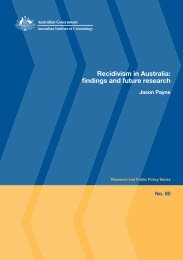Review of anti-corruption strategies Rob McCusker - Australian ...
Review of anti-corruption strategies Rob McCusker - Australian ...
Review of anti-corruption strategies Rob McCusker - Australian ...
Create successful ePaper yourself
Turn your PDF publications into a flip-book with our unique Google optimized e-Paper software.
Transparency International’s Global <strong>corruption</strong> barometer 2005 leaves little room to doubt the wide<br />
ranging influence <strong>of</strong> <strong>corruption</strong> within and upon a number <strong>of</strong> sectors and institutions. A questionnaire<br />
sought opinions from some 55,000 people in 69 low, middle and high income countries on a number<br />
<strong>of</strong> issues relating to the prevalence and impact <strong>of</strong> <strong>corruption</strong> including their assessment <strong>of</strong> the levels <strong>of</strong><br />
<strong>corruption</strong> within a number <strong>of</strong> sectors and institutions (Figure 2). Political parties were perceived as the<br />
most corrupt, followed by parliament/legislature, police, and legal system/judiciary.<br />
Figure 2: Global <strong>corruption</strong> barometer<br />
Source: Adapted from Transparency International 2005<br />
The definition <strong>of</strong> <strong>corruption</strong> and an appreciation <strong>of</strong> its nature and extent are crucial to understanding<br />
whether and if so, how, an <strong>anti</strong>-<strong>corruption</strong> strategy might be formulated, implemented and assessed. An<br />
important starting point is to address two key questions:<br />
•<br />
•<br />
what types <strong>of</strong> <strong>corruption</strong> are the most damaging and in which institutions or countries?<br />
what are the relationships between <strong>corruption</strong> and poverty and how can a state reduce <strong>corruption</strong>?<br />
Within those two framing questions, three broad levels <strong>of</strong> assessment should occur:<br />
•<br />
•<br />
Political parties<br />
Parliament/legislature<br />
Police<br />
Legal system/judiciary<br />
Business/private sector<br />
Tax revenue<br />
Customs<br />
Media<br />
Medical services<br />
Utilities<br />
Education system<br />
Military<br />
Registry and permit services<br />
NGOs<br />
Religious bodies<br />
1 2 3 4 5<br />
causes and impact <strong>of</strong> <strong>corruption</strong> – for example, how far the causes <strong>of</strong> <strong>corruption</strong> are influenced by<br />
geographical, political, economic and cultural factors, and by the relationships between political and<br />
administrative processes, and between public and private sector<br />
the political, economic, institutional and social environment – for example, whether the <strong>corruption</strong> is<br />
country or institution specific and whether different political, administrative and economic<br />
configurations give rise to differing levels or types <strong>of</strong> <strong>corruption</strong> and thus to differing impacts on<br />
different groups in society<br />
2.6<br />
2.8<br />
2.9<br />
2.9<br />
3.0<br />
3.0<br />
3.2<br />
3.2<br />
3.3<br />
3.4<br />
3.4<br />
3.5<br />
3.6<br />
3.7<br />
4.0<br />
Key<br />
1 = not at all corrupt<br />
5 = extremely corrupt















